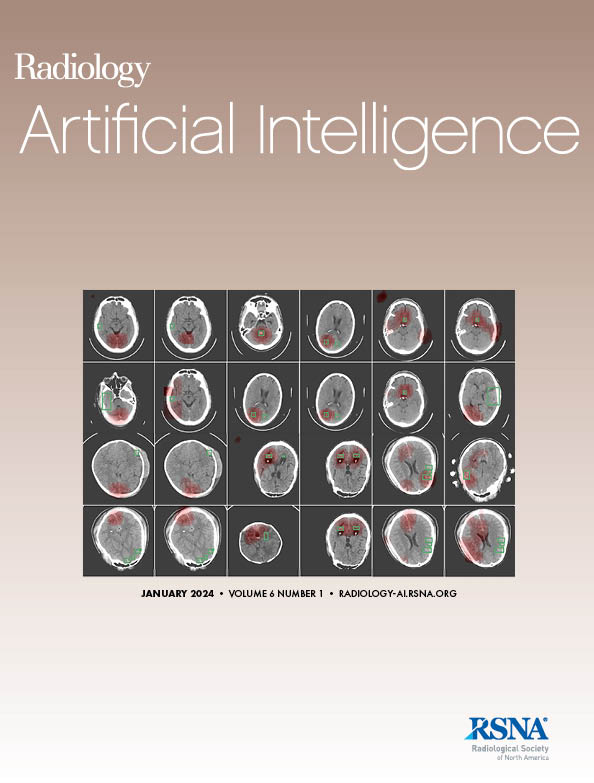Batuhan Gundogdu, Aritrick Chatterjee, Milica Medved, Ulas Bagci, Gregory S Karczmar, Aytekin Oto
下载PDF
{"title":"Physics-Informed Autoencoder for Prostate Tissue Microstructure Profiling with Hybrid Multidimensional MRI.","authors":"Batuhan Gundogdu, Aritrick Chatterjee, Milica Medved, Ulas Bagci, Gregory S Karczmar, Aytekin Oto","doi":"10.1148/ryai.240167","DOIUrl":null,"url":null,"abstract":"<p><p>Purpose To evaluate the performance of Physics-Informed Autoencoder (PIA), a self-supervised deep learning model, in measuring tissue-based biomarkers for prostate cancer (PCa) using hybrid multidimensional MRI. Materials and Methods This retrospective study introduces PIA, an emerging self-supervised deep learning model that integrates a three-compartment diffusion-relaxation model with hybrid multidimensional MRI. PIA was trained to encode the biophysical model into a deep neural network to predict measurements of tissue-specific biomarkers for PCa without extensive training data requirements. Comprehensive in silico and in vivo experiments, using histopathology measurements as the reference standard, were conducted to validate the model's efficacy in comparison to the traditional nonlinear least squares (NLLS) algorithm. PIA's robustness to noise was tested in in silico experiments with varying signal-to-noise ratio (SNR) conditions, and in vivo performance for estimating volume fractions was evaluated in 21 patients (mean age, 60 years ± 6.6 [SD]; all male) with PCa (71 regions of interest). Evaluation metrics included the intraclass correlation coefficient (ICC) and Pearson correlation coefficient. Results PIA predicted the reference standard tissue parameters with high accuracy, outperforming conventional NLLS methods, especially under noisy conditions (<i>r</i><sub>s</sub> = 0.80 vs 0.65, <i>P</i> < .001 for epithelium volume at SNR of 20:1). In in vivo validation, PIA's noninvasive volume fraction estimates matched quantitative histology (ICC, 0.94, 0.85, and 0.92 for epithelium, stroma, and lumen compartments, respectively; <i>P</i> < .001 for all). PIA's measurements strongly correlated with PCa aggressiveness (<i>r</i> = 0.75, <i>P</i> < .001). Furthermore, PIA ran 10 000 faster than NLLS (0.18 second vs 40 minutes per image). Conclusion PIA provided accurate prostate tissue biomarker measurements from MRI data with better robustness to noise and computational efficiency compared with the NLLS algorithm. The results demonstrate the potential of PIA as an accurate, noninvasive, and explainable artificial intelligence method for PCa detection. <b>Keywords:</b> Prostate, Stacked Auto-Encoders, Tissue Characterization, MR-Diffusion-weighted Imaging <i>Supplemental material is available for this article.</i> ©RSNA, 2025 See also commentary by Adams and Bressem in this issue.</p>","PeriodicalId":29787,"journal":{"name":"Radiology-Artificial Intelligence","volume":" ","pages":"e240167"},"PeriodicalIF":13.2000,"publicationDate":"2025-03-01","publicationTypes":"Journal Article","fieldsOfStudy":null,"isOpenAccess":false,"openAccessPdf":"https://www.ncbi.nlm.nih.gov/pmc/articles/PMC11950878/pdf/","citationCount":"0","resultStr":null,"platform":"Semanticscholar","paperid":null,"PeriodicalName":"Radiology-Artificial Intelligence","FirstCategoryId":"1085","ListUrlMain":"https://doi.org/10.1148/ryai.240167","RegionNum":0,"RegionCategory":null,"ArticlePicture":[],"TitleCN":null,"AbstractTextCN":null,"PMCID":null,"EPubDate":"","PubModel":"","JCR":"Q1","JCRName":"COMPUTER SCIENCE, ARTIFICIAL INTELLIGENCE","Score":null,"Total":0}
引用次数: 0
引用
批量引用
Abstract
Purpose To evaluate the performance of Physics-Informed Autoencoder (PIA), a self-supervised deep learning model, in measuring tissue-based biomarkers for prostate cancer (PCa) using hybrid multidimensional MRI. Materials and Methods This retrospective study introduces PIA, an emerging self-supervised deep learning model that integrates a three-compartment diffusion-relaxation model with hybrid multidimensional MRI. PIA was trained to encode the biophysical model into a deep neural network to predict measurements of tissue-specific biomarkers for PCa without extensive training data requirements. Comprehensive in silico and in vivo experiments, using histopathology measurements as the reference standard, were conducted to validate the model's efficacy in comparison to the traditional nonlinear least squares (NLLS) algorithm. PIA's robustness to noise was tested in in silico experiments with varying signal-to-noise ratio (SNR) conditions, and in vivo performance for estimating volume fractions was evaluated in 21 patients (mean age, 60 years ± 6.6 [SD]; all male) with PCa (71 regions of interest). Evaluation metrics included the intraclass correlation coefficient (ICC) and Pearson correlation coefficient. Results PIA predicted the reference standard tissue parameters with high accuracy, outperforming conventional NLLS methods, especially under noisy conditions (r s = 0.80 vs 0.65, P < .001 for epithelium volume at SNR of 20:1). In in vivo validation, PIA's noninvasive volume fraction estimates matched quantitative histology (ICC, 0.94, 0.85, and 0.92 for epithelium, stroma, and lumen compartments, respectively; P < .001 for all). PIA's measurements strongly correlated with PCa aggressiveness (r = 0.75, P < .001). Furthermore, PIA ran 10 000 faster than NLLS (0.18 second vs 40 minutes per image). Conclusion PIA provided accurate prostate tissue biomarker measurements from MRI data with better robustness to noise and computational efficiency compared with the NLLS algorithm. The results demonstrate the potential of PIA as an accurate, noninvasive, and explainable artificial intelligence method for PCa detection. Keywords: Prostate, Stacked Auto-Encoders, Tissue Characterization, MR-Diffusion-weighted Imaging Supplemental material is available for this article. ©RSNA, 2025 See also commentary by Adams and Bressem in this issue.
混合多维MRI前列腺组织微观结构分析的物理信息自编码器。
“刚刚接受”的论文经过了全面的同行评审,并已被接受发表在《放射学:人工智能》杂志上。这篇文章将经过编辑,布局和校样审查,然后在其最终版本出版。请注意,在最终编辑文章的制作过程中,可能会发现可能影响内容的错误。目的评估物理信息自动编码器(PIA),一种自我监督的深度学习模型,在使用混合多维MRI测量前列腺癌(PCa)的组织生物标志物方面的性能。材料和方法本回顾性研究介绍了PIA,一种新型的自监督深度学习模型,它将三室扩散-松弛模型与混合多维MRI相结合。PIA经过训练,将生物物理模型编码为深度神经网络,以预测PCa的组织特异性生物标志物的测量,而无需大量的训练数据要求。以组织病理学测量值为参考标准,进行了全面的计算机和体内实验,验证了该模型与传统非线性最小二乘(NLLS)算法的有效性。在不同信噪比(SNR)条件下的计算机实验中测试了PIA对噪声的鲁棒性,并评估了21例患者(平均年龄60岁(SD:6.6)岁;所有男性)均有PCa (n = 71个感兴趣的区域)。评价指标包括类内相关系数(ICC)和Pearson相关系数。结果PIA预测参考标准组织参数准确率高,优于传统的NLLS方法,特别是在噪声条件下(rs = 0.80 vs 0.65,在信噪比= 20:1时,P < 0.001)。在体内验证中,PIA的无创体积分数估计值与定量组织学相匹配(上皮、间质和管腔室的ICC分别为0.94、0.85和0.92,P < 0.001)。PIA测量值与前列腺癌侵袭性强相关(r = 0.75, P < 0.001)。此外,PIA的运行速度比NLLS快10,000(每张图像0.18秒对40分钟)。结论与NLLS算法相比,PIA算法能够从MRI数据中准确测量前列腺组织生物标志物,对噪声具有更好的鲁棒性和计算效率。结果表明,PIA作为一种准确、无创、可解释的PCa检测人工智能方法的潜力。©RSNA, 2025年。
本文章由计算机程序翻译,如有差异,请以英文原文为准。

 求助内容:
求助内容: 应助结果提醒方式:
应助结果提醒方式:


